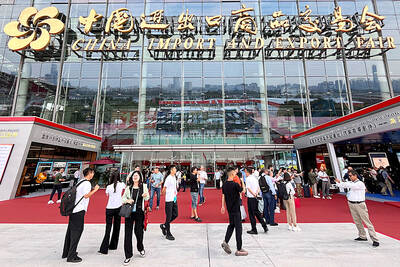Never mind the sports. The real battle in Beijing is not the struggle to top the medal table, but the multibillion-dollar fight between two giant brands intent on conquering the fastest-growing sportswear market in the world.
Adidas and Nike have invested unprecedented sums in wooing Chinese consumers during the Olympics. The German firm is estimated to have spent US$190 million on sponsorship and associated marketing; its US rival has stumped up close to US$150 million.
Adidas is sponsoring the Games, as well as the Chinese Olympic committee. Torchbearers, officials and volunteers are all clad in the brand; so too are Chinese champions.
“Every single Chinese athlete winning a medal will be in Adidas on the podium,” said Paul Pi (畢寶元), vice-president of marketing for Adidas China.
But Nike has fought back by sponsoring the Chinese teams in 22 of 28 Olympic sports.
At the root of this rivalry is a market a fraction the size of that of the US — but growing at 30 percent annually for the past five years.
“If you want to lead globally, you have to lead in China,” Pi said.
Nike says it passed the US$1 billion sales mark this spring, a year ahead of schedule. Adidas says it has leapfrogged its rival in becoming market leader by the start of the Games, with sales up 60 percent in the first half of this year — though its claim is based on factors such as brand image. It is “on course” to reach US$1.5 billion by 2010.
“They are absolutely neck and neck,” Terry Rhoads of Shanghai-based sports specialists Zou Marketing said.
“Adidas had to have this sponsorship,” said Greg Paull, co-founder of marketing consultants R3, who believes the brand was at risk because of Nike’s deals with individual athletes.
“We expected the Olympics would not be a powerful marketing tool — but the opposite has been the case. The market hasn’t matured to the stage of the US or UK in terms of marketing literacy and the celebrity aspect is still very strong,” he said.
Adidas has tapped into the national passion for sport with a campaign that gives its standard slogan a patriotic twist: “Together in 2008 — Impossible is nothing.”
“Other countries are interested in the Olympics. But in China well over 90 percent of people are passionate and supportive and want to be involved,” Pi said.
Meanwhile, Nike’s “Courage” advertising spots emphasize individual achievement.
“For us, it’s about connecting with athletes: We make products that make them perform better and then build on the excitement that creates,” said Nike spokesman Charlie Brookes, citing the ultralight Hyperdunk shoe for Kobe Bryant or Asafa Powell’s Zoom Aerofly.
The real race is outside the Olympic zone. Adidas, which is opening stores at the rate of two a day, will have 5,000 shops in China by the end of the year. Its new store in Sanlitun — several kilometers away from the Bird’s Nest stadium — opened last month and is the largest in the world, with 3,170m² of retail space over four floors. There is a rooftop basketball court, a smoothie bar, computer terminals to customize trainers and exercise stations. A gallery showcases the footwear Adidas has made for the Games, from boxing boots to slides for divers — all presented in glass cases and lit with artistic reverence.
Nike has slightly fewer outlets, and its flagship store is a mere 1,208m², but its Wangfujing location is one of Beijing’s premier shopping hubs. It also boasts a gallery in the 798 art district, where the current exhibition traces the brand’s development — and not a single item is for sale.
Meanwhile, the two companies face competition from sporting icon turned entrepreneur Li Ning (李寧). The three-time gold medalist demonstrated his gymnastic flair as he “ran” around the top of the Bird’s Nest Stadium before lighting the Olympic cauldron — albeit dressed in Adidas. But to many young Chinese people he is now as well known for his eponymous sportswear brand: sales reached US$750 billion last year. After his appearance, his Hong Kong-listed stock rose 3.5 percent.

SECURITY: As China is ‘reshaping’ Hong Kong’s population, Taiwan must raise the eligibility threshold for applications from Hong Kongers, Chiu Chui-cheng said When Hong Kong and Macau citizens apply for residency in Taiwan, it would be under a new category that includes a “national security observation period,” Mainland Affairs Council (MAC) Minister Chiu Chui-cheng (邱垂正) said yesterday. President William Lai (賴清德) on March 13 announced 17 strategies to counter China’s aggression toward Taiwan, including incorporating national security considerations into the review process for residency applications from Hong Kong and Macau citizens. The situation in Hong Kong is constantly changing, Chiu said to media yesterday on the sidelines of the Taipei Technology Run hosted by the Taipei Neihu Technology Park Development Association. With

CARROT AND STICK: While unrelenting in its military threats, China attracted nearly 40,000 Taiwanese to over 400 business events last year Nearly 40,000 Taiwanese last year joined industry events in China, such as conferences and trade fairs, supported by the Chinese government, a study showed yesterday, as Beijing ramps up a charm offensive toward Taipei alongside military pressure. China has long taken a carrot-and-stick approach to Taiwan, threatening it with the prospect of military action while reaching out to those it believes are amenable to Beijing’s point of view. Taiwanese security officials are wary of what they see as Beijing’s influence campaigns to sway public opinion after Taipei and Beijing gradually resumed travel links halted by the COVID-19 pandemic, but the scale of

A US Marine Corps regiment equipped with Naval Strike Missiles (NSM) is set to participate in the upcoming Balikatan 25 exercise in the Luzon Strait, marking the system’s first-ever deployment in the Philippines. US and Philippine officials have separately confirmed that the Navy Marine Expeditionary Ship Interdiction System (NMESIS) — the mobile launch platform for the Naval Strike Missile — would take part in the joint exercise. The missiles are being deployed to “a strategic first island chain chokepoint” in the waters between Taiwan proper and the Philippines, US-based Naval News reported. “The Luzon Strait and Bashi Channel represent a critical access

Pope Francis is be laid to rest on Saturday after lying in state for three days in St Peter’s Basilica, where the faithful are expected to flock to pay their respects to history’s first Latin American pontiff. The cardinals met yesterday in the Vatican’s synod hall to chart the next steps before a conclave begins to choose Francis’ successor, as condolences poured in from around the world. According to current norms, the conclave must begin between May 5 and 10. The cardinals set the funeral for Saturday at 10am in St Peter’s Square, to be celebrated by the dean of the College